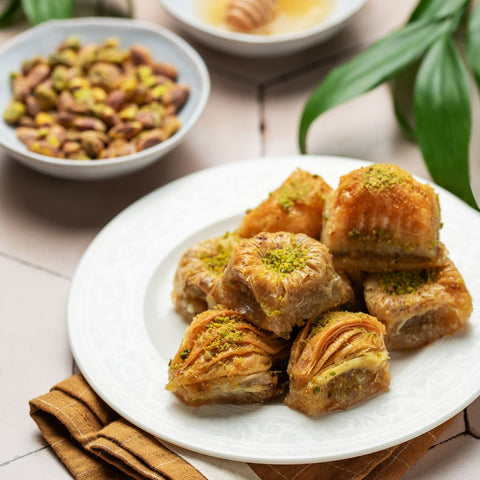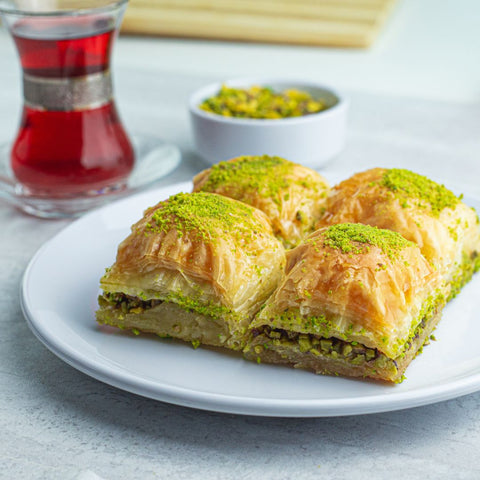Embark on a delectable journey through the cultural heritage of Turkish cuisine, where the iconic dessert known as baklava reigns supreme. Originating from the heart of Turkey, baklava is more than just a sweet treat; it's a symbol of tradition, craftsmanship, and the rich tapestry of Turkish culinary history. Let us delve into the fascinating origins of Turkish baklava, its enduring legacy, and its delightful variations that tantalize taste buds worldwide.
Turkish Roots of Baklava

An Artisanal Craftsmanship

Crafting authentic Turkish baklava is a labour of love, requiring skill, precision, and an unwavering commitment to tradition. The process begins with the painstaking preparation of paper-thin sheets of phyllo dough, a task that demands patience and expertise. Each layer is delicately brushed with clarified butter, creating a crisp, golden exterior that shatters delicately upon the first bite. The filling, typically a blend of finely ground nuts such as pistachios or walnuts, is generously layered between the buttery sheets, creating a symphony of textures and flavours.
The Essence of Turkish Baklava

What truly sets Turkish baklava apart is its signature syrup, delicately infused with fragrant rose water or orange blossom essence. This aromatic syrup is poured over the baked pastry, seeping into every layer and infusing the dessert with a luscious, sweet flavour and a floral aroma that tantalizes the senses. The result is a confectionary masterpiece that epitomizes the essence of Turkish hospitality and culinary excellence.
Variations and Taste
While the traditional Turkish baklava is a testament to its rich heritage, there are delightful variations that offer unique flavours and textures. From the buttery richness of Antep baklava, filled with prized pistachios from the Gaziantep region, to the lighter, fluffier texture of şöbiyet, a variation filled with sweetened cream, each version offers a distinctive taste experience that delights the palate.
The Difference Between Turkish and Greek Baklava

Turkish and Greek baklava, while sharing similarities in their basic ingredients and preparation methods, boast distinct characteristics that set them apart. Turkish baklava is renowned for its delicate layers of paper-thin phyllo dough, generously filled with finely chopped nuts, typically pistachios or walnuts, and sweetened with a fragrant syrup infused with rose water or orange blossom water. The result is a symphony of flavors and textures, with a balance of nuttiness, sweetness, and floral notes. In contrast, Greek baklava tends to be richer and sweeter, often incorporating honey in the syrup for added sweetness and depth of flavour. Additionally, Greek baklava may feature a wider variety of nuts in the filling, including almonds and pecans, contributing to its distinctive taste profile. While both versions of baklava are beloved desserts in their respective cultures, each offers a unique sensory experience that reflects the culinary traditions and preferences of its origin.
Embracing Homemade Baklava
While store-bought versions of baklava offer convenience, nothing quite compares to the sensory experience of indulging in a homemade creation. Crafting baklava from scratch allows you to pay homage to centuries-old traditions, infuse the process with your personal touch, and create cherished memories with loved ones. By embracing homemade baklava, you not only embark on a culinary adventure but also honour the rich heritage and cultural significance of this beloved dessert.
Conclusion
In conclusion, Turkish baklava is more than just a dessert; it's a culinary masterpiece that embodies the spirit of Turkish hospitality, craftsmanship, and tradition. From its humble origins in the kitchens of the Ottoman Empire to its enduring popularity on dessert tables around the world, baklava continues to captivate and delight with its irresistible allure. So, let's embark on our own culinary journey and discover the rich heritage of Turkish baklava with a homemade creation that pays homage to centuries of tradition.
Homemade Turkish Baklava Recipe
Ingredients:
- 450g phyllo dough, thawed if frozen
- 225g unsalted butter, melted
- 200g mixed nuts (such as pistachios, walnuts, and almonds), finely chopped
- 1 teaspoon ground cinnamon (optional)
- 240ml water
- 200g granulated sugar
- 1 tablespoon lemon juice
- 1 tablespoon rose water or orange blossom water
Instructions:
- Preheat your oven to 175°C and grease a 23x33cm baking dish with melted butter.
- In a mixing bowl, combine the chopped nuts with ground cinnamon, if desired, and set aside.
- Unroll the phyllo dough onto a clean, flat surface and cover it with a damp towel to prevent drying.
- Brush the bottom of the baking dish with melted butter. Place a sheet of phyllo dough in the dish, allowing the edges to hang over the sides, and brush it with more melted butter.
- Layer half of the phyllo sheets in the dish, brushing each layer with butter.
- Spread the nut mixture evenly over the phyllo layers.
- Layer the remaining phyllo sheets on top of the nut mixture, brushing each layer with butter.
- Using a sharp knife, carefully cut the baklava into diamond or square shapes.
- Bake in the preheated oven for 45-50 minutes, or until golden brown and crisp.
- While the baklava is baking, prepare the syrup by combining water, sugar, and lemon juice in a saucepan. Bring to a boil, then reduce the heat and simmer for 10 minutes.
- Remove the syrup from the heat and stir in the rose water or orange blossom water.
- Once the baklava is done baking, remove it from the oven and immediately pour the hot syrup over the hot baklava. Allow it to cool completely before serving.





Comments (0)
There are no comments for this article. Be the first one to leave a message!